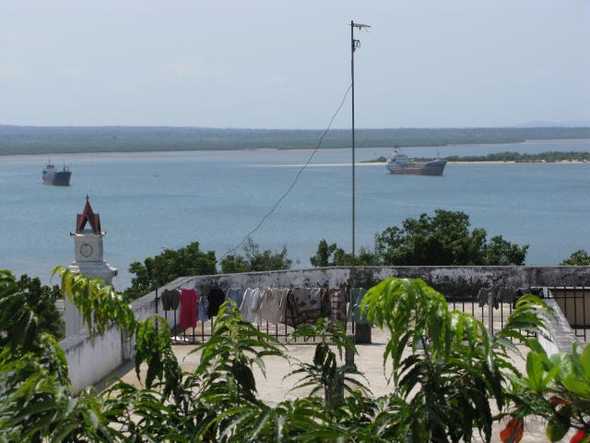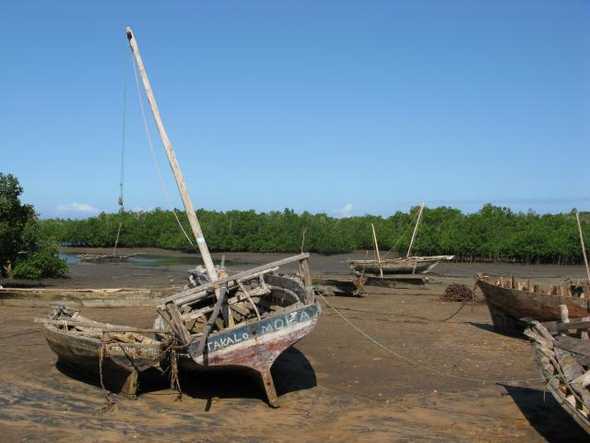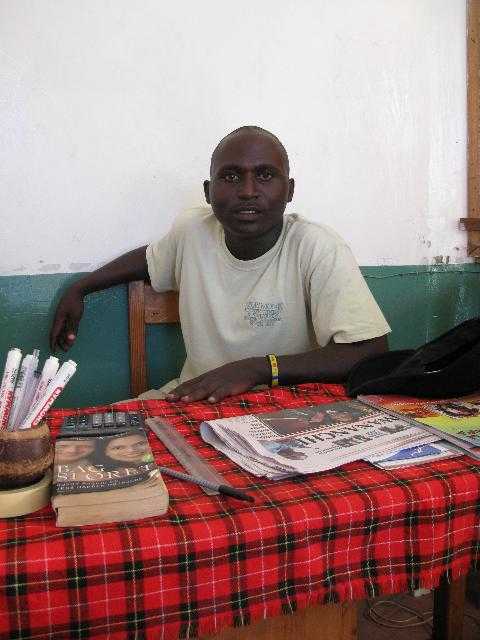Typed up: at New Palm Tree Hotel in Mombasa, at Coral Cove Cottages in Tiwi Beach Posted from: Internet cafe in Mombasa

Every once in a while we would stop, and I would hope that enough people could get off so at least it wouldn’t be so crowded. I silently cheered when the fold down seat next to me was folded down, but then two people sat down on it which squeezed is even more than we already had been. BTW, no chivalry in Tanzania. I don’t think I ever saw anybody give up their seat, and husbands sit before their wives do.






After the cave tour was over we biked back to Tanga, but not without stopping to sample coconut wine. Making it is so amazingly simple that it might make one religious. You climb up a palm tree, cut off a leave, and hang a bucket over the wound. Then 12 hours later you go to collect the bucket, and you have a legitimate, pretty tasty alcoholic beverage. That’s the entire process. And it keeps on giving, too, just cut the leaf back a little bit further and you can do it again. I would say that anybody in California who has a problem getting their own brew to taste good, should just plant some palm trees and use this method.
Back in Tanga, Emilias took us to a locals restaurant for lunch. I think this is the first place we’d eaten where we didn’t see any other tourists, and it was a good experience. The menu was simple (fish or chicken, ugali or rice, …) and the food was good. It was all cooked right on the other side of the partition next to our table. It was really cheap, too. Tsh. 12,000 (\$1.67) per person, including a soft drink. Then we got a little break before the afternoon portion of the tour.
Apparently the first choice vehicle did not come through, so we rode to the Tongoni ruins in a nice 4-door sedan. It was not the ideal car, because most of the road was dirt and in questionable condition. On the way we listened to Bob Marley tapes. I hadn’t heard any reggae in Africa yet. So far it’s been a lot of what I’d call club music. Lots of beat, with a little melody.



That night we spent some time talking to Jeller, yet another Dutch traveler, as we ate dinner at Patwas. The food was nice, but the chicken had a ton of little bones in it, and I’m still not quite used to that. We turned in for another early night, and were only disturbed by loud guests.
In the morning we had plenty of time to make our noon bus, but I was feeling pretty unprepared to venture into Kenya. We didn’t have any guide book info printed out (although we had some on the laptop) and printing in Tanga is prohibitively expensive (Tsh 500 / USD 0.42 per page). We didn’t have any Kenyan shillings either, and because it was Sunday everything was closed. So we killed some time eating a second breakfast. A real omelette is much better than a complimentary 1-egg omelette. At the bus station I also tried a local cookie type thing. It appeared to be made with just flour, sugar, and some spices which tasted a little bit like a ginger bread cookie. 1 was nice, but the 2nd one felt like a little much.
Then the bus came (late), and we piled in. The bus didn’t leave for another 20 minutes or so, so we shouldn’t’ve hurried. Just a little ways out of Tanga the road became unpaved, and the next 40 kilometers were a very bumpy ride. The bus didn’t really slow down unless there was a major ditch to cross. Eventually the bus stopped, and we all got out to hand over our exit forms to the Tanzanian government. We also changed money at some guy holding a big wad of bills. The exchange rate was highly unfavorable, but we only changed about 18 dollars so at least we had something to use in Kenya. This slowed us down enough to be the last people back on the bus, and in fact the bus was already moving when we got back on it. The bus drove a little further where we got off again to formally get into Kenya.
First we got in a police line where they wrote down our names in a big book. Then we stood in line for immigration. The bus operators had given us a Kenya entry form, which we’d dutifully filled out. However, that wasn’t good enough. When we got to immigration officer (close to the end of our bus line, because we were seated almost at the back of the bus) he gave us another form to fill out. We hastily filled it out, worried that the bus might leave without us, or at least that we were annoying all the passengers who had to wait for us. We queued back up, but one of the bus conductors pulled us right into the immigration officer’s office, and put our passports under his nose. The officer continued processing the queue outside the window for a while before he dealt with us. It was very straightforward. We gave him the form and the USD 50 per person, and we got some pretty stickers in our passports. We hurried back to the bus, which did not in fact leave right when we got back on so perhaps they weren’t waiting for us after all.
Not surprisingly, the Kenyan landscape is much the same as the Tanzanian. The biggest difference is that in Kenya the road is paved, while in Tanzania it is not. Eventually we entered the outskirts of Mombasa, which had many dirt roads going off the main road, stone buildings with 2 stories, and finally a ferry. We drove onto the ferry after the conductor had come by to close all the curtains. I have no idea why. Then after the ferry it was just a short trip to our bus company’s office in downtown Mombasa. Downtown appeared to be all paved, the buildings were taller, there were side walks, and lots of taxis and tuk-tuks on the road. Our bags were unloaded from the belly of the bus and returned to us absolutely covered in dust. I think they sat near a wheel well with some holes or something, but we took it all in stride. We hailed a tuk-tuk to take us to our hotel, and were charged a fair price. There was no negotiating or foreigner price to be upset about. Danielle tipped the guy 50%. We walked into the New Palm Tree Hotel, where a 1-bed double room was available.